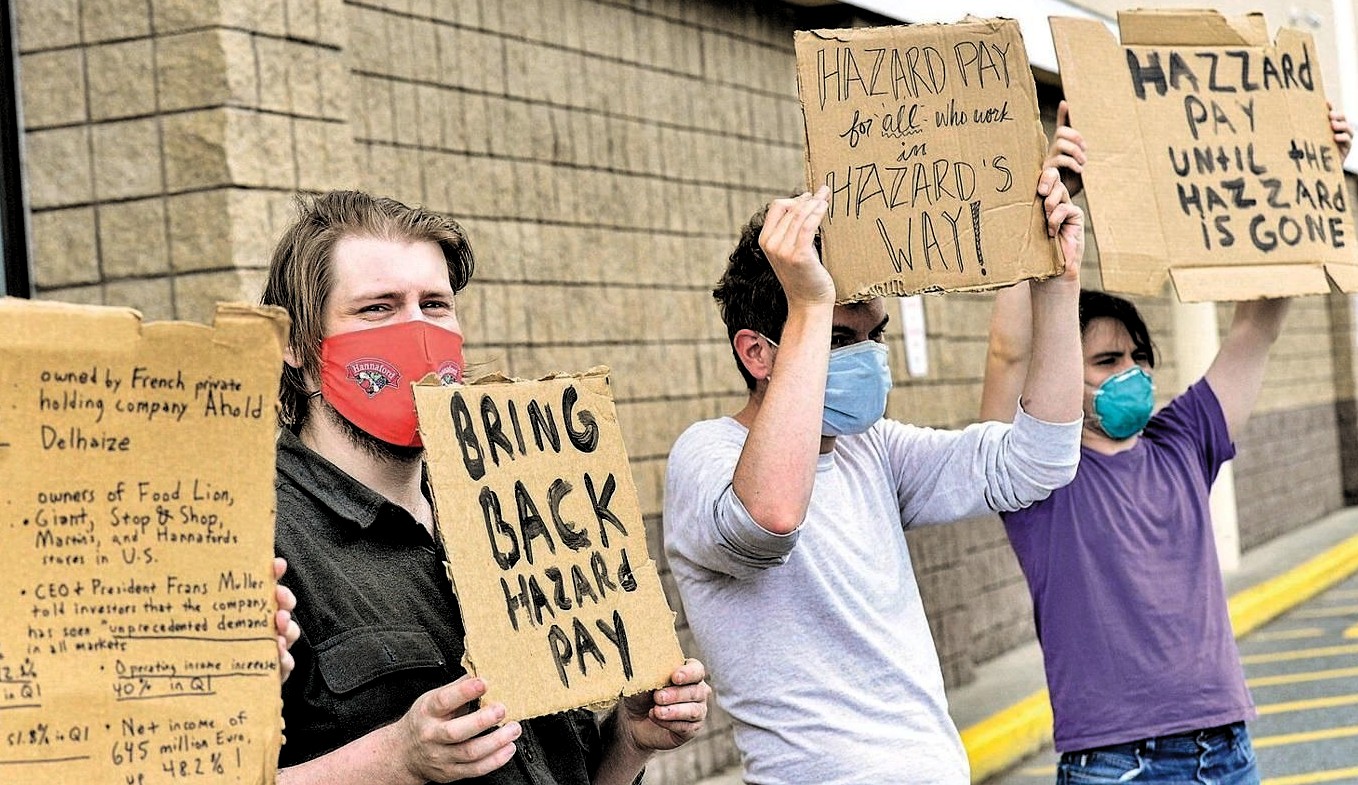

Workers at a Brattleboro, Vt., supermarket walked out June 29 to protest the company’s cancellation of hazard pay related to the COVID pandemic.
The Trump administration has admitted it has no plan to get COVID-19 under control. White House chief of staff Mark Meadows told CNN Oct. 25 that “We are not going to control the pandemic. We are going to control the fact that we get vaccines, therapeutics and other mitigation areas.”
This a very risky strategy, given that the vaccines and therapeutics don’t yet exist. What Meadows is really saying is more workers will be risking their lives as they are forced back to work to make ends meet, and the government will do nothing to help them. The workers facing the greatest challenge are those who started with the lowest wages and those who face systemic oppression. That’s what the statistics reveal.
Workers in the U.S. have faced unemployment rates as high as 14.9% in 2020. In September it was 8.9% for all workers — and those rates omit underemployed and discouraged workers.
If you look at unemployment rates for workers of color, as reported by the Current Population Survey, the inequalities jump out: 7.2% for white workers, Latinx workers 11.2%, Black workers 13.2% — almost double the rate for white workers. For all women, the unemployment rate is higher than for men.
A large percentage of Black and Latinx women are concentrated in service and retail jobs and have been hit especially hard. Under the pressures of e-commerce and the pandemic, nearly a million retail workers have lost their jobs, which were low-paying to begin with. Even when restaurants and stores are open, customers stay away out of fear of becoming infected. This creates additional hardship for workers dependent on tips or sales commission.
The lowest-paid workers — with little to no emergency savings — now face the highest unemployment. The number of jobs for workers who were making less than $14 an hour has dropped by 20% since January. The number of jobs paying between $14 and $20 an hour has fallen by almost as much — 16%, while the number of jobs for workers making $32 or more per hour has increased by 2%. (Current Population Survey)
Bosses get richer, workers get sick
While workers are suffering under the lash of unemployment and being forced to take dangerous, low-paid jobs to survive, the rich are getting richer. Google’s third quarter revenue amounted to $46.02 billion, up from $37.99 billion in the preceding quarter. Amazon reported revenue for its third fiscal quarter of 2020 up 37% from 2019, to $96.1 billion.
One area of retail still operating at full capacity is grocery stores, including the Amazon-owned Whole Foods. While their owners are raking in billions in profits, grocery workers still face deadly risks every day — even though the bosses cut off their “hazard bonus” pay.
Workers at a Brattleboro, Vt., supermarket walked out June 29 to protest the company’s cancellation of hazard pay related to the COVID pandemic.
According to the Washington Post (Aug. 12), “At least 130 U.S. grocery workers have died, and more than 8,200 have tested positive for the novel coronavirus since late March.” Hazard pay or no hazard pay, given the current high unemployment rates, workers are willing to take the jobs.
The big bosses — who know how desperate workers are to put food on the table for their families and keep a roof over their heads — pile on the work, cut hours and force workers to deal with customers without masks who won’t heed social distancing. Some workers are so disgusted at their treatment that they quit mid-shift. But others are so desperate that they come to work sick.
U.S. statistics compared with China’s
The Commerce Department reported that the U.S. output of goods and services, Gross Domestic Product, fell off the cliff in the second quarter (April, May, June). It declined by 9.5%, about $450 billion. This was the biggest percentage decline since 1875. This followed a first quarter decline.
Even after the U.S. GDP grew by 7% in the third quarter, aided by the March stimulus package, the U.S. economy has declined by 3.5% since the beginning of January.
Compare this to China’s growth rate of 1.9% according to the World Bank. China, which has had 4,746 deaths from 91,921 COVID-19 cases according to WHO, has managed to control the pandemic there.
China has exhibited an orderly, scientific and highly organized response on a national scale. China’s government still plans to end poverty before 2021 despite the pandemic. It plans to arrive at a moderately prosperous society for all by 2030 and reach a developed, socialist economy by 2050.
What is clear is that U.S. workers need a new approach to control this pandemic and its economic impact. China might provide a good example of what is needed.
Raposo is a Portuguese Marxist analyst, editor of the web magazine jornalmudardevida.net, where this article…
By Alireza Salehi The following commentary first appeared on the Iranian-based Press TV at tinyurl.com/53hdhskk.…
This is Part Two of a series based on a talk given at a national…
Educators for Palestine released the following news release on July 19, 2025. Washington, D.C. Educators…
On July 17, a court in France ordered the release of Georges Abdallah, a Lebanese…
The following are highlights from a speech given by Yemen’s Ansarallah Commander Sayyed Abdul-Malik Badr…